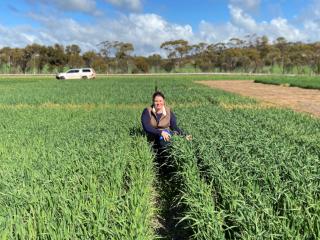Spring growing conditions are a critical factor in determining how important it is to cut hay at the optimal growth stage for yield, quality, and overall returns, research trials have revealed.
Findings from 2020 oaten hay trials at Muresk in Western Australia and Rupanyup in Victoria were delivered at the Grains Research and Development Corporation Grains Research Updates, Merredin last week.
Department of Primary Industries and Regional Development (DPIRD) oat research agronomist and project lead Georgie Troup said the study looked at the effect of plant growth stage at cutting on hay yield and quality.
“Trials sown in early May measured a range of hay quality traits and compared cutting dates across six varieties - Brusher, Carrolup, Koorabup, Mulgara, Wintaroo and Yallara,” Ms Troup said.
“Three key crop growth stages were examined – as soon as the crop emerged from the boot; at the watery ripe stage which is current industry practice; and 14 days after watery ripe.
“At Muresk, a drier than average spring was experienced. While hay yield increased as the crop progressed through the growth stages where hay cuts were taken, this was detrimental to hay quality.
“At Rupanyup, which had a wetter than average spring, most oat varieties maintained hay quality up to 14 days after watery ripe, and yield significantly increased as the crop matured.”
Hay quality traits examined included water soluble carbohydrates, acid detergent fibre, neutral detergent fibre, and leaf chlorophyll, which collectively influence the nutritional value, palatability and digestibility of the product.
Ms Troup said the results were analysed alongside previous DPIRD research that was undertaken in 2005 and 2006. The results indicated that spring growing conditions were a critical factor in determining what impact a delay in cutting stage may have on hay quality.
“Growers with a large hay program, who experience a dry spring may start mowing earlier than watery ripe to reduce the risk of quality downgrading of the crop cut at the end of the mowing program.
“In a typical growing season, cutting hay before watery ripe may produce better quality hay with lower stem thickness, but there will likely be a yield penalty.
“With adequate spring moisture, such as at Rupanyup in 2020, the optimum hay cutting window may be broader. The increased hay yield achieved by cutting after the water ripe phase may not be at the expense of hay quality.”
The trials are part of the National Hay Agronomy project, funded by AgriFutures Australia, to address current knowledge gaps in the Australian export fodder industry.
The project is led by DPIRD with support from the South Australian Research and Development Institute, Agriculture Victoria, New South Wales Department of Primary Industries and grower groups.

Media contacts:
Katrina Bowers/Megan Broad, media liaison
+61 (0)8 9368 3937
